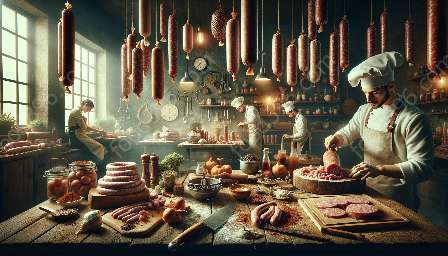When it comes to sausage making and food preservation, sensory evaluation and quality analysis play crucial roles. In this comprehensive topic cluster, we will delve into the intricacies of sausage sensory evaluation and quality analysis, and its interconnections with sausage making and food preservation & processing.
The Art and Science of Sausage Making
Sausage making is an ancient culinary art that has evolved over centuries. It involves the process of mixing ground meat, fat, salt, and other ingredients, which are then stuffed into casings. The choice of ingredients, the blending process, and the casing used all contribute to the sensory attributes of sausages.
Understanding Food Preservation & Processing
Food preservation and processing techniques are essential to extend the shelf life of perishable foods and maintain their quality. Sausage making often involves preservation methods such as curing, smoking, or fermentation. These processes not only impact the sensory attributes but also play a significant role in quality analysis.
Importance of Sensory Evaluation
The sensory evaluation of sausages involves analyzing their appearance, aroma, flavor, texture, and overall palatability. These attributes are subjective and can vary based on individual preferences. Through sensory evaluation, food scientists and producers can assess the organoleptic properties of sausages and make informed decisions regarding product quality.
Elements of Sensory Evaluation
1. Appearance: The visual appeal of sausages, including color, shape, and surface characteristics.
2. Aroma: The characteristic smell of sausages, influenced by ingredients, spices, and the cooking process.
3. Flavor: The taste perception of sausages, including basic tastes (sweet, sour, salty, bitter), as well as complex flavor profiles.
4. Texture: The mouthfeel of sausages, encompassing aspects such as tenderness, juiciness, and chewiness.
5. Palatability: The overall sensory satisfaction and acceptability of sausages to the consumer.
Quality Analysis of Sausages
The quality of sausages is influenced by various factors such as raw materials, processing techniques, and storage conditions. Quality analysis aims to measure and maintain the standards of sausages, ensuring they meet consumer expectations and regulatory requirements.
Factors Affecting Sausage Quality
1. Ingredients: The selection and quality of raw materials, including meat, fat, spices, and additives, significantly impact sausage quality.
2. Processing: The methods used for grinding, mixing, stuffing, and cooking affect the texture, flavor, and overall quality of sausages.
3. Packaging and Storage: Proper packaging materials and storage conditions are critical to preserving the freshness and quality of sausages throughout their shelf life.
Connection to Food Preservation & Processing
The sensory evaluation and quality analysis of sausages are closely intertwined with food preservation and processing. Techniques such as curing, smoking, and fermentation not only contribute to the unique sensory attributes of sausages but also serve as preservation methods that impact their overall quality.
The Role of Sensory Evaluation in Sausage Making
In the context of sausage making, sensory evaluation acts as a guiding principle for creating products that resonate with consumer preferences. Understanding the sensory profiles of different ingredients and processing techniques allows sausage makers to tailor their products to meet specific flavor and texture expectations.
Advancements in Quality Control and Sensory Analysis
With advancements in food science and technology, the field of sensory analysis has witnessed significant developments. Modern analytical tools and techniques allow for precise measurement and characterization of sensory attributes, leading to enhanced quality control measures in sausage production.
Conclusion
Sausage sensory evaluation and quality analysis are integral components of sausage making and food preservation. By understanding the sensory attributes and conducting rigorous quality analysis, producers can ensure that the sausages meet the expectations of consumers while upholding the standards of quality and safety.

